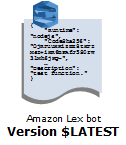End of support notice: On September 15, 2025, AWS will discontinue support for Amazon Lex V1. After September 15, 2025, you will no longer be able to access the Amazon Lex V1 console or Amazon Lex V1 resources. If you are using Amazon Lex V2, refer to the Amazon Lex V2 guide instead. .
Versioning and Aliases
Amazon Lex supports publishing versions of bots, intents, and slot types so that you can control the implementation that your client applications use. A version is a numbered snapshot of your work that you can publish for use in different parts of your workflow, such as development, beta deployment, and production.
Amazon Lex bots also support aliases. An alias is a pointer to a specific version of a bot. With an alias, you can easily update the version that your client applications are using. For example, you can point an alias to version 1 of your bot. When you are ready to update the bot, you publish version 2 and change the alias to point to the new version. Because your applications use the alias instead of a specific version, all of your clients get the new functionality without needing to be updated.
Topics
Versioning
When you version an Amazon Lex resource you create a snapshot of the resource so that you can use the resource as it existed when the version was made. Once you've created a version it will stay the same while you continue to work on your application.
The $LATEST Version
When you create an Amazon Lex bot, intent, or slot type there is only one version,
the $LATEST version.

$LATEST is the working copy of your resource. You can update only the
$LATEST version and until you publish your first version,
$LATEST is the only version of the resource that you have.
Only the $LATEST version of a resource can use the
$LATEST version of another resource. For example, the
$LATEST version of a bot can use the $LATEST version
of an intent, and the $LATEST version of an intent can use the
$LATEST version of a slot type.
The $LATEST version of your bot should only be used for manual
testing. Amazon Lex limits the number of runtime requests that you can make to the
$LATEST version of the bot.
Publishing an Amazon Lex Resource Version
When you publish a resource, Amazon Lex makes a copy of the $LATEST
version and saves it as a numbered version. The published version can't be changed.

You create and publish versions using the Amazon Lex console or the CreateBotVersion operation. For an example, see Exercise 3: Publish a Version and Create an Alias.
When you modify the $LATEST version of a resource, you can publish
the new version to make the changes available to your client applications. Every
time you publish a version, Amazon Lex copies the $LATEST version to
create the new version and increments the version number by 1. Version numbers are
never reused. For example, if you remove a resource numbered version 10 and then
recreate it, the next version number Amazon Lex assigns is version 11.
Before you can publish a bot, you must point it to a numbered version of any intent that it uses. If you try to publish a new version of a bot that uses the $LATEST version of an intent, Amazon Lex returns an HTTP 400 Bad Request exception. Before you can publish a numbered version of the intent, you must point the intent to a numbered version of any slot type that it uses. Otherwise you will get an HTTP 400 Bad Request exception.

Note
Amazon Lex publishes a new version only if the last published version is
different from the $LATEST version. If you try to publish the
$LATEST version without modifying it, Amazon Lex doesn't create or
publish a new version.
Updating an Amazon Lex Resource
You can update only the $LATEST version of an Amazon Lex bot, intent,
or slot type. Published versions can't be changed. You can publish a new version any
time after you update a resource in the console or with the CreateBotVersion, the CreateIntentVersion or
the CreateSlotTypeVersion operations.
Deleting an Amazon Lex Resource or Version
Amazon Lex supports deleting a resource or version using the console or one of the API operations:
Aliases
An alias is a pointer to a specific version of an Amazon Lex bot. Use an alias to allow client applications to use a specific version of the bot without requiring the application to track which version that is.
The following example shows two versions of an Amazon Lex bot, version version 1 and version 2. Each of these bot versions has an associated alias, BETA and PROD, respectively. Client applications use the PROD alias to access the bot.

When you create a second version of the bot, you can update the alias to point to the new version of the bot using the console or the PutBot operation. When you change the alias, all of your client applications use the new version. If there is a problem with the new version, you can roll back to the previous version by simply changing the alias to point to that version.

Note
Although you can test the $LATEST version of a bot in the console, we
recommend that when you integrate a bot with your client application, you first
publish a version and create an alias that points to that version. Use the alias in
your client application for the reasons explained in this section. When you update
an alias, Amazon Lex will wait until the session timeout of all current sessions expires
before it starts using the new version. For more information about the session
timeout, see Setting the Session
Timeout